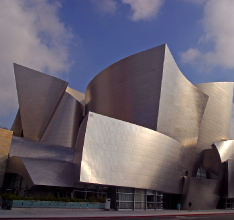Though I reside in Santa Barbara, I am in Los Angeles a good deal for meetings and other events. When I’m in the city, I like to walk the downtown neighborhood. My favorite building to look at while I’m on these strolls is the Disney Theatre, home base of the LA Philharmonic and the creation of Frank Gehry, probably the best-known architect in the world. Like many of Gehry’s other buildings, the Disney is marked by shimmering metallic surfaces, curving planes, and an overall playfulness of design. Some have suggested that the theatre’s exterior looks like the pages of a score that have just fallen from the conductor’s podium. That it is a captivating work of art is testified to by the crowds that regularly gather round it to gaze and to take photographs. Soon after I arrived in the LA Archdiocese, I heard that Gehry was actually one of the finalists in the competition to design the new Cathedral here. To say the very least, it would have been interesting to see what he would have done with that assignment.
This connection came vividly to mind when I read a recent interview with Gehry, conducted in advance of his ninetieth birthday. After ruminating on his long and productive career, the architect said that he still harbored a great desire: “I would like to design a church or a synagogue. A place that has transcendence. I’ve always been interested in space that transcends to something—to joy, pleasure, understanding, discourse, whatever a space can do to be part of the dialogue.” We can easily recognize in this statement what I would call the “Augustinian longing.” The great Church Father, Augustine of Hippo, long ago wrote, “Lord, you have made us for yourself; therefore our heart is restless until it rests in you.” Whether we like it or not, whether we explicitly acknowledge it or not, all of us are marked by the hunger and thirst for a good that transcends the goods available in this world. As C.S. Lewis observed, this desire of the heart reveals itself particularly in moments of intense joy, for it is precisely when we have achieved a great worldly value—fame, pleasure, power, money, etc.—that we realize that we still want and need something more. This is the beauty and goodness to which religion points, the transcendence to which it is meant to order us.
But here’s the rub. As he elaborated on the meaning of “transcendence,” Gehry said this: “Forget the religion aspect. How do you make a space feel transcendent? How do you create a sense of ease with the universe, the rain, the stars and the people around you? It’s comforting to sit in a big room and listen to the rain.” In stating it this way, the architect revealed his perspective as a pagan one. Please don’t misunderstand me; I have a deep respect for pagan religion. In fact, my mentor, Msgr. Robert Sokolowski, once told me, “If you stop being a Christian, I’d recommend becoming a pagan. Paganism is a noble religion, for it has to do with honoring the great natural necessities.” He meant that this ancient spiritual tradition, available in both mythic and philosophical expressions, had to do with ordering human beings toward a right relationship with the earth, the sea, the natural processes of life and death, etc. This was the “transcendence” that paganism evoked. I put the word in quotes because it did not signal, in that context, values that go beyond the world—only values that go beyond the self.
There is a poetic and ecstatic passage in St. Augustine’s Confessions that articulates the fundamental difference between a biblical and a pagan conception of transcendence. The spiritual searcher wonders what is the object that truly corresponds to the aching within his heart:
“What is the object of my love? And I asked the earth and it said: ‘It is not I.’ I asked all that is in it; they made the same confession. (Job 28:12f). I asked the sea, the deeps, the living creatures that creep, and they responded: ‘We are not your God. look beyond us.’ I asked the breezes that blow and the entire air with its inhabitants said: ‘Anaximenes was mistaken; I am not God.’ I asked heaven, sun, moon, and stars; they said: ‘Nor are we the God whom you seek.’ And I said to all those things in the external environment: ‘Tell me of my God who you are not, tell me something about him.’ and with great voice they cried out ‘He made us.’”
To understand that citation is to grasp the difference between biblical religion and paganism. Augustine makes it eminently clear that, even as he reverences the goods of nature, he knows that his heart wants something more, indeed something infinitely more.
One of the distinctive marks of our time is a secularism that has got us stuck within the world that we can see and measure. What this ideology does with the Augustinian longing for God is to turn it into the neo-paganism evident in Frank Gehry’s statement. It is as though the desire that pushes us beyond this world to its Creator gets stifled, limited, corralled, so that we end up effectively worshiping “the universe, the rain, the stars.” Mind you, I think that biblical believers carry an awful lot of the blame for the re-emergence of paganism, for we have obviously presented the Creator God in such an unconvincing manner to the culture. The Church ought to sing the transcendence of God to Frank Gehry as it once sang it to Giotto, Michelangelo, Caravaggio, Dante, Gaudí, and the architect of Chartres Cathedral.
Once the great architect realizes that the deepest desire of his heart is for the living God, I would love to see the church he would build.
